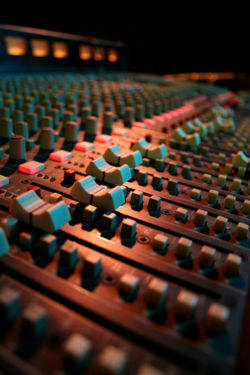This article was first
published
on CLUAS in September 2008
The Making of an Album, part 2: Where to Record
Second of a four part guide to recording an album...
Last
week we talked about the pre-production process.
Just to underline what we said - before you think about recording: rehearse,
rehearse, rehearse!
 So now you have your 10 or so songs and you've made sure that, in terms of
arrangement, structure and lyrics, they are the best they can be. At this point
it might be a good idea to discuss the possibility of getting a producer on
board. Most bands with a small budget will side step this option by either
hiring an engineer with production experience or by producing the material
themselves, or both.
So now you have your 10 or so songs and you've made sure that, in terms of
arrangement, structure and lyrics, they are the best they can be. At this point
it might be a good idea to discuss the possibility of getting a producer on
board. Most bands with a small budget will side step this option by either
hiring an engineer with production experience or by producing the material
themselves, or both.
However, it is worth checking out a producer whose sole job is to concentrate
on production. The producer's job is to work with the band to make sure their
music is both professional sounding and commercially viable. At the end of the
day you're going to have to sell it! Look up producers (the
Hot Press Yearbook
is a good starting point), talk to a few and if you find someone that suits you
and your music then great. If you don't, well it's back to you and the engineer
undertaking the production duties. Make sure the engineer and producer hear all
of your material before you start recording. Decisions on how the album should
be approached should be made before you book the studio.
So you've rehearsed and found a producer/engineer. That really is the dog work
done. Once the right personnel are chosen, hopefully all other options will fall
into place.
The next piece of the puzzle is where to record. Do you want to hire a
purpose-built studio? Or would you prefer to record somewhere else?
Let's start with a purpose-built studio. No doubt we've all seen behind-the-scenes footage of your favourite band recording in a cavernous live room while their engineer is slaving over a huge desk with many lights and knobs. They are very impressive looking. Indeed, studios like Grouse Lodge, Windmill, The Cauldron, Sun and Apollo are places that this writer gets goosebumps about. But let's get away from the 'wow!' factor for a moment and discuss the real advantages and disadvantages of these studios.
Purpose-built studios have the advantage of being sound proofed and sound
designed, with all the recording equipment you will need under one roof. Some,
like Grouse Lodge, even has accommodation, a pool and your very own chef!
The disadvantages to a band on a small budget are all too obvious: the money.
Prices for the mid-range studios start from €500 per day and can go all the way
up to as much as €1500 per day. That's not including the engineer either! If you
are to consider a studio to record in then you must be aware that you will be
limited in terms of the amount of time you have, although for some bands a
deadline can work very well.
The other option for a place to record is to go mobile. Forty years ago
The Rolling Stones started this with their studio in a truck; it produced
some amazing recordings but it wasn't exactly a featherweight. Now, however,
thanks to digital technology, all the studio equipment you will need will fit
into a Volvo estate. By having your entire recording process mobile you can
record anywhere. To rent a large 8-bedroom holiday home in the middle of the
country will set you back about €900 for one week. Even if you factor in the
cost of equipment rental, the savings are huge when compared to a studio. Aside
from the cost, the other main advantage is that you are isolated from the
outside world - no clubs, no Internet and no distractions in general. You'd be
amazed at how the introduction of a friend or partner into the recording process
can cause disruption!
There are disadvantages, though. Number one is the blindingly obvious fact that
you aren't in a studio. You have the equipment but not the fixtures and
fittings. What that means is that there is no soundproofing and, more
importantly, no sound designing. The soundproofing can be dealt with. If you are
in the middle of nowhere you don't have to worry about noise levels, i.e. the
sheep won't care about the noise and you hopefully won't hear them complain if
they do! More important is the sound designing. The mid-range studio will have a
few different types of rooms: a wood room, a stone room and a dead room most
likely. The wood and stone rooms are for drums and anything you want to sound
spacious, while the dead room for that close, intimate sound.
Before you decide on a location make sure it has rooms that your instruments
sound good in. Good starting points are solid walls, wood floors and some soft
furnishings to calm the higher frequency reflections (i.e. echo). The tough one
is the dead room, though. Often, creative use of those soft furnishings and some
blankets can give good results.
There is always a third option of combining the two. For example, if you want a
certain drum sound that you feel only a certain studio will give you, then you
can hire the studio solely for the drums and then disappear off to your hideaway
to record all the rest of the tracks.
A quick word of warning. This writer recorded in a haunted house recently. If
you are easily freaked out, which I am, then make sure you get the history of
the building before you rent it out! An engineer that is afraid to go asleep is
a very grumpy engineer indeed!
OK, so all the personnel are in place and you have a place to record. Next we
get down to the business of recording.
Andy Knightley
This is the 2nd part of 4 part series of articles on 'Making an album'. Check out the other articles:
The author Andy Knightley is a sound engineer who runs Krecording, which provides mobile recording and the facilities of Studio 57 in Dublin. He has recorded the likes of Sinead O'Connor, Bell X1, Damien Dempsey, Lir, Ronnie Drew (RIP), The Rags, Pilotlight, Le Galaxie/66e, Vasco Junior and Michele Ann Kelly. If you have any questions for Andy, feel free to contact him at info@krecording.com
